
What is Blue Lotus?
Blue lotus, or Nymphaea caerulea, is a water lily from the Nile river, traditionally used in ancient Egyptian herbalism. Today, it is still used to promote relaxation, ease anxiety, improve sleep, and achieve an altered state of consciousness.
In this article, we’ll take a closer look at the blue lotus, including a discussion of its history, effects, and safety.

History of the Blue Lotus
Although blue lotus can now be found in lakes and rivers worldwide, it is best associated with ancient Egyptian culture. In fact, records of the blue lotus plant date back to at least the 14th century B.C. on ancient Egyptian papyri and tombs.
However, the medicinal and spiritual use of blue lotus also spread to other cultures. It was revered in ancient Greece and Rome, as well as India as a component of Ayurvedic medicine.
In addition to its therapeutic benefits, the blue lotus was (and still is) renowned for its beauty and the cyclical nature of its blooming pattern. During blooming season, the flowers open mid-morning and close in the afternoon, a symbol of rebirth. Today, the blue lotus is a popular ornament in landscaping.

What Does Blue Lotus Do?
Like most herbal substances, the original use of blue lotus was both medicinal and spiritual. Ancient Egyptians would have used it for health benefits and potentially during spiritual rituals.
Today, its general use remains much the same. Blue lotus can be used for mental health benefits, such as relieving anxiety and promoting relaxation. It can also be used for spiritual benefits, for those seeking an altered state of consciousness.
With current technology, we now understand that the effects of blue lotus flowers can be attributed to a diverse range of chemical compounds. The metabolites of the blue lotus flowers have been shown to have pain-relieving, anti-inflammatory, and antimicrobial properties. Blue lotus is rich in a class of compounds called polyphenols, which can scavenge free radicals to halt and reverse oxidative processes. Oxidative processes are involved in biological aging, disease, and food spoilage.
In addition to the therapeutic properties of this remarkable water lily, many have also sought the mind-altering benefits of blue lotus throughout its history. The blue lotus has psychoactive properties and can even induce hallucinations and euphoria at higher doses.

Blue Lotus Flower Effects
The two compounds primarily responsible for the psychoactive effects of the blue lotus water lily are called apomorphine and nuciferine. Both of these compounds influence the dopamine system in the brain to alter mood and alertness. While apomorphine has the effect of enhancing alertness and boosting mood, nuciferine an opposing effect which is more sedative. Apomorphine may also influence the serotonergic system in the brain. Think serotonin – the molecule best associated with happiness and well-being (although that’s a bit of an over-simplification).
Together, these two compounds, apomorphine and nuciferine, act synergistically to create the overall mind-altering effects of the blue lotus flower.

Safety of Blue Lotus
Despite its long history of use, there is limited safety data on the blue lotus. Although commercial products will often be market as natural, it is not a GRAS classified compound. Safety data is somewhat limited to our understanding of the individual chemical components of the blue lotus lily, which does not account for potential synergistic effects between the compounds. Additionally, the blue lotus is a complex matrix and there are also many unidentified chemical compounds that may or may not be hazardous at certain doses.
That said, existing safety data suggests that blue lotus does not present major safety concerns. Additionally, the long history of use in traditional herbalism is another mark in favor of its safety.
As with all traditional herbs, there are sometimes new safety risks presented when they are removed from the cultural and traditional contexts. For example, herbs like kratom and kava saw a rise in safety concerns as soon as they were introduced to the west. All herbs should be treated with the respect and caution they deserve. Just because they are “natural” plants does not mean that they can’t be powerful!

Commercially Available Blue Lotus
Blue lotus is available commercially in a variety of forms including:
· Dried leaves
· Teas
· Plant resins
· Flower extracts
· Oils
· Concentrates
· Electronic cigarettes
As we discussed above in the safety section, traditional herbal practices don’t always translate seamlessly into modern day use. There’s an interesting note on this with respect to the blue lotus.
A 2023 study looked at the chemical composition of authentic blue lotus samples as compared to some commercial blue lotus samples. The researchers used the gold standard of analytical techniques, called gas chromatography – mass spectrometry to see what chemicals are naturally found in each of the samples.
Interestingly, they found that the authentic samples differed significantly from the commercial samples. The commercial samples didn’t even smell like the authentic samples, and were found to have added synthetic fragrance.
This isn’t necessarily a bad thing, but it is an important disclaimer if you wish to assess the safety of blue lotus products solely on the basis of historical usage.

How to Make Blue Lotus Tea
Blue lotus tea can be brewed from the dried leaves, simply by soaking the leaves in hot water for up to 10 minutes. A shorter brew time will result in a weaker tea, and therefore a lower dosage of the biologically active compounds in blue lotus. This method will help you to achieve the more therapeutic effects of blue lotus.
On the other hand, a stronger tea made with more leaves soaked for the full 15 minutes will deliver a more concentrated dose of blue lotus compounds. This will result in intense sedation or possibly euphoria.
Obviously, this isn’t a very precise science. The temperature and volume of your water will heavily influence how much tea gets extracted as well. However, as a rule of thumb, you can test out 5 g of dried leaves for a lower dose, and 10 g for a higher dose. We always recommend to start low and go slow as you experiment with a new drug or herb. If you are using a commercial product, follow the instructions on the label. With any mind-altering substance, pay close attention to your mood, expectations, and environment to help optimize your experience.

How to Smoke Blue Lotus
Another popular method for consuming blue lotus is to smoke it. You can make your own hand-made rolls using the dried leaves, or you can purchase rolls for convenience. Blue lotus dried leaves can be mixed with other substances for smoking, to enhance the flavor and experience, but always exercise caution when combining more than one biologically active substance. You may also be able to find blue lotus as a liquid meant for electronic cigarette.
Recap on Blue Lotus
We hope this has been an intriguing introduction to this beautiful, ancient herbal remedy. If you have additional questions about the blue lotus, please feel free to contact us for more information.








